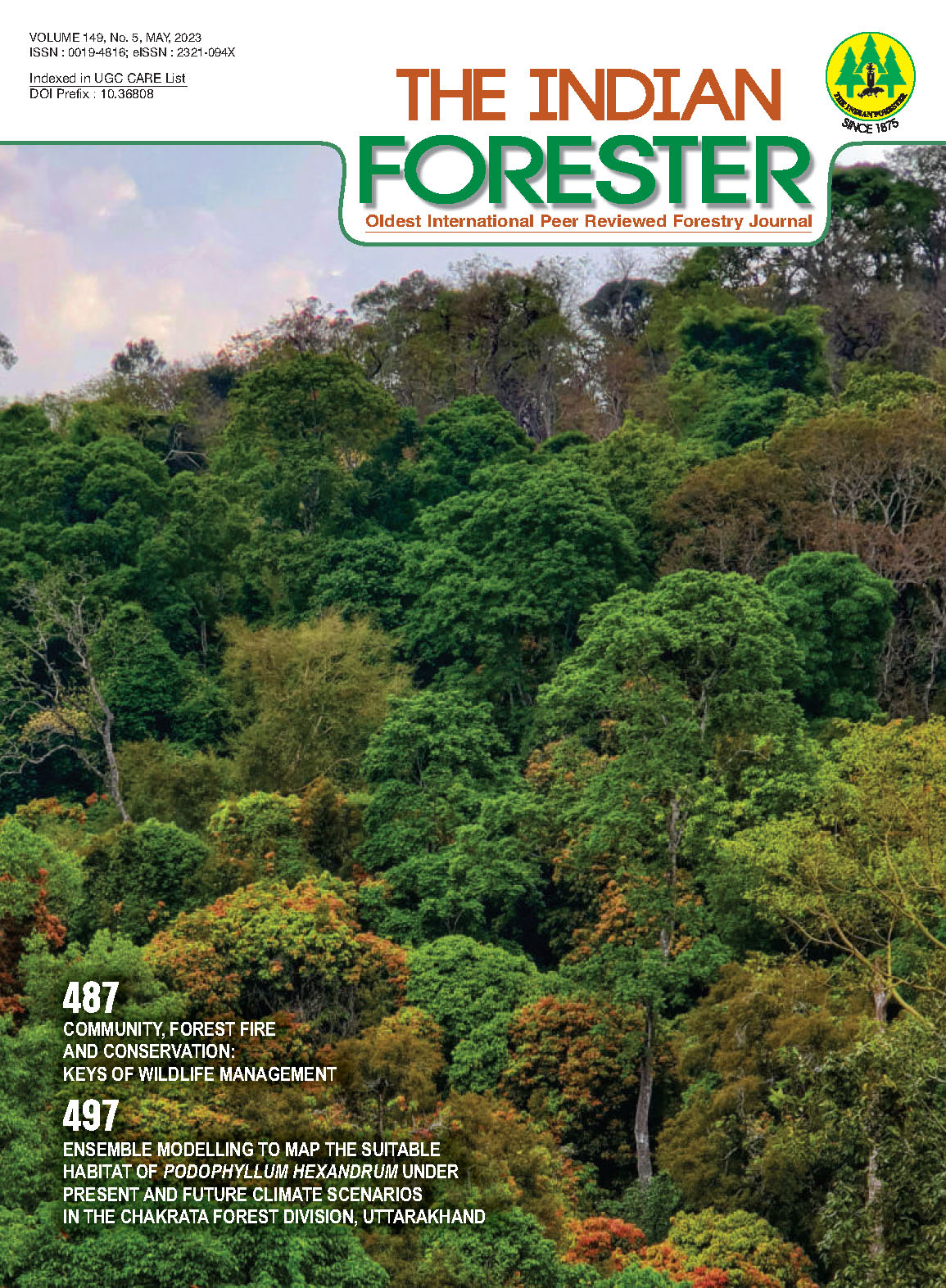Seed Dispersal Potential of Two Domestic Herbivores: Who Poops the Most Seeds?
DOI:
https://doi.org/10.36808/if/2023/v149i5/169419Keywords:
Domestic Herbivore, Dung, Endozoochory, Free-Grazing, Seed Dispersal, Seedling Emergence.Abstract
Endozoochory is an important mechanism in free-grazing ecosystems with a high potential to modify the dynamics of vegetation. Here, we examine two domestic herbivores (cow and buffalo) for their seed dispersal potential in free-grazing agroecological landscapes. Twenty fresh dung samples of each herbivore were collected, and the fresh weight of each sample was measured. The presence of viable seeds in the pile was estimated through the seedling emergence method traditionally used for soil seed bank studies. A total of 2058 seedlings of 68 species emerged from 40 dung samples; cow and buffalo dispersed 59 and 48 species, respectively, sharing 39 common species. Among them, 21 were monocots and the remaining (47) dicots. Despite the low weight of the pile of dung, there were more seeds (1298) dispersed by cow than by buffalo (760). This study concludes that domestic herbivores have a high seed dispersal potential that needs to be explored in more detail. Currently, seed dispersal is an understudied field of ecological research in India, despite the high faunal and floral diversity. Thus, this study highlights the need for more active seed dispersal research in Indian ecological studies.References
Anderson T.M., Schütz M. and Risch A.C. (2014). Endozoochorous seed dispersal and germination strategies of Serengeti plants. Journal of vegetation science, 25(3): 636-647.
Auffret A.G. and Cousins S.A. (2011). Past and present management influences the seed bank and seed rain in a rural landscape mosaic. Journal of Applied Ecology, 48(5): 278-1285.
Climate-Data (2020). Climate data for cities worldwide. Available at https://en.climate-data.org/. Accessed on 28th April 2020.
Cosyns E., Claerbout S., Lamoot I. and Hoffmann M. (2005). Endozoochorous seed dispersal by cattle and horse in a spatially heterogeneous landscape. Plant Ecology, 178(2): 149-162.
Cosyns E. and Hoffmann M. (2005). Horse dung germinable seed content in relation to plant species abundance, diet composition and seed characteristics. Basic and Applied Ecology, 6(1): 11-24.
Cousens R.D., Hill J., French K. and Bishop I.D. (2010). Towards better prediction of seed dispersal by animals. Functional Ecology, 24(6): 1163-1170.
Cunningham E.P. and Syrstad O. (1989). Crossbreeding Bos indicus and Bos taurus for milk production in the tropics. Food and Agriculture Organization of the United Nations, Rome (No. FAO APHP-68). https://www.fao.org/publications
Fazelian S., Tahmasebi K.P. and Shirmardi H.A. (2014). Endozoochorous seed dispersal of plant species in semisteppe rangelands. International Journal of Advanced Biological and Biomedical Research, 2(2): 473-486.
Herrera C.M. and Pellmyr O. (2002). Plant-animal interactions: An evolutionary approach. Blackwell Publishing, Oxford, UK.
Janzen D.H. (1984). Dispersal of small seeds by big herbivores: foliage is the fruit. The American Naturalist, 123(3): 338-353.
Jaroszewicz B., Pirożnikow E. and Sondej I. (2013). Endozoochory by the guild of ungulates in Europe's primeval forest. Forest Ecology and Management, 305(1): 21–28.
Jordano P. (2000). Fruits and frugivory. In: Fenner M, editor. Seeds: the ecology of regeneration in plant communities. 2nd edition. Wallingford: CABI Publishing, pp. 125-165.
Konsam B., Phartyal S.S. and Todaria N.P. (2020). Impact of forest fire on soil seed bank composition in Himalayan Chir pine forest. Journal of Plant Ecology, 13(2): 177-184.
Ministry of Environment Forest and Climate Change (2019). Implementation of India's National Biodiversity Action, An Overview. Available at www.nbaindia.org. Accessed on 20th December 2020.
Ministry of Fisheries, Animal Husbandry and Dairying (2019). 20th Livestock Census. All India Report, DAHD&F. Available at th www.dahd.nic.in. Accessed on 20 December 2020.
Mouissie A.M., Vos P., Verhagen H.M.C. and Bakker J.P. (2005). Endozoochory by free-ranging, large herbivores: ecological correlates and perspectives for restoration. Basic and Applied Ecology, 6(6): 547-558.
Myers P., Espinosa R., Parr C.S., Jones T., Hammond G.S. and Dewey T.A. (2020). The Animal Diversity Web. Available at https://animaldiversity.org. Accessed on 20th March 2020.
Okamura B., Hartikainen H. and Trew J. (2019). Waterbird-Mediated Dispersal and Freshwater Biodiversity: General Insights from Bryozoans. Frontiers in Ecology and Evolution, 7: 29.
Picard M., Chevalier R., Barrier R., Boscardin Y. and Baltzinger C. (2016). Functional traits of seeds dispersed through endozoochory by native forest ungulates. Journal of Vegetation Science, 27(5): 987–998.
Poschlod P., Abedi M., Bartelheimer M., Drobnik J., Rosbakh S. and Saatkamp A. (2013). Seed ecology and assembly rules in plant communities. In: E. van der Maarel and J. Franklin, editor. nd Vegetation Ecology. 2 edition. Blackwell Publishing, Oxford, UK, pp.164-202.
Rosbakh S., Chalmandrier L., Phartyal S.S. and Poschlod P. (2022). Inferring community assembly processes from functional seed trait variation along elevation gradient. Journal of Ecology, 110 (10) : 2374-2387.
Rubalcava-Castillo F.A., Sosa-RamÃrez J., Luna-RuÃz J.J., Valdivia-Flores A.G., DÃaz-Núñez V. and Ãñiguez-Dávalos L.I. (2020). Endozoochorous dispersal of forest seeds by carnivorous mammals in Sierra FrÃa, Aguascalientes, Mexico. Ecology and Evolution, 10(6): 2991–3003.
Schurr F.M., Steinitz O. and Nathan R. (2008). Plant fecundity and seed dispersal in spatially heterogeneous environments: models, mechanisms and estimation. Journal of Ecology, 96(4): 628–641.
Sekar N., Lee C.L. and Sukumar R. (2015). In the elephant's seed shadow: the prospects of domestic bovids as replacement dispersers of three tropical Asian trees. Ecology, 96(8): 2093-2105.
Sekar N. and Sukumar R. (2013). Waiting for Gajah: an elephant mutualist contingency plan for an endangered megafaunal disperser. Journal of Ecology, 101(6): 1379-1388.
Soberon J. (2007). Grinnellian and eltonian niches and geographic distributions of species. Ecology Letters, 10(12): 1115–1123.
Sridhara S., McConkey K., Prasad S. and Corlett R.T. (2016). Frugivory and seed dispersal by large herbivores of Asia. In: Ahrestani, F., Sankaran, M, editor. The ecology of large herbivores in South and Southeast Asia. Springer, Dordrecht, pp. 121-150.
Ter Heerdt G.N.J., Verweij G.L., Bekker R.M. and Bakker J.P. (1996). An improved method for seed-bank analysis: seedling emergence after removing the soil by sieving. Functional Ecology, 10(1): 144-151.
Wand S.L. and Hou F.J. (2021). Seed bank of livestock dung in the Qilian Mountain grassland: A potential resource for vegetation recovery. Rangeland Ecology & Management, 78:90-99.
Downloads
Downloads
Published
How to Cite
Issue
Section
License
Unless otherwise stated, copyright or similar rights in all materials presented on the site, including graphical images, are owned by Indian Forester.





